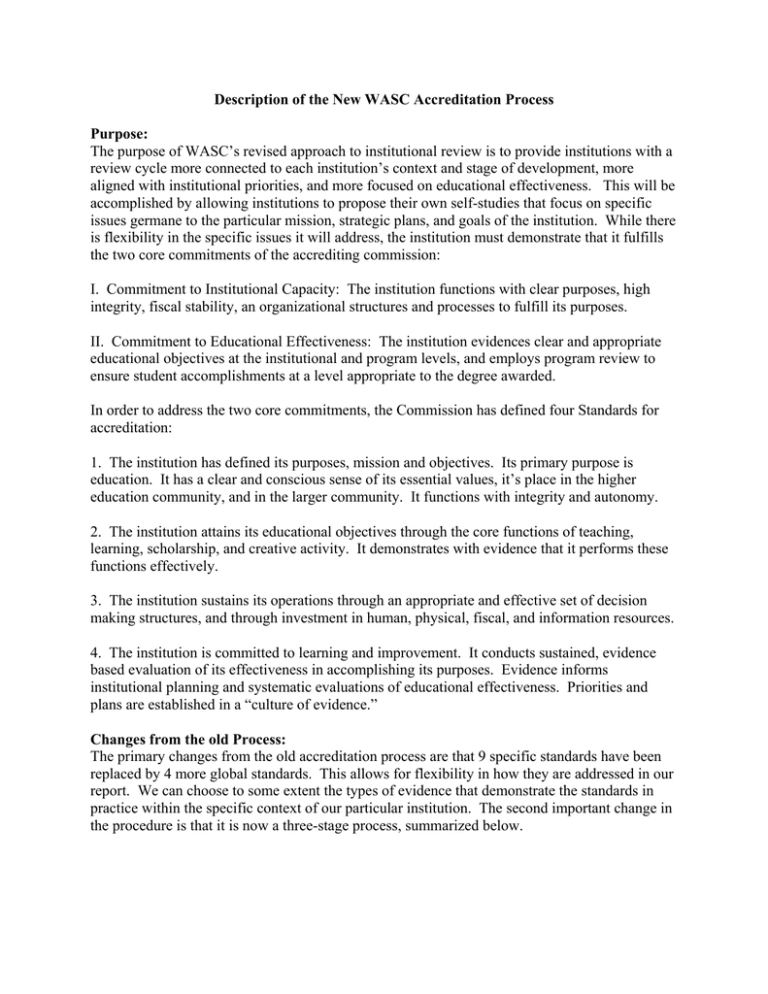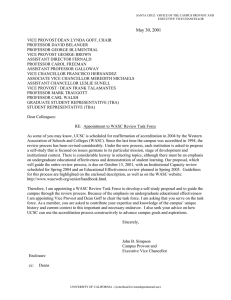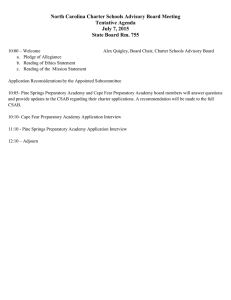Description of the New WASC Accreditation Process Purpose:
advertisement

Description of the New WASC Accreditation Process Purpose: The purpose of WASC’s revised approach to institutional review is to provide institutions with a review cycle more connected to each institution’s context and stage of development, more aligned with institutional priorities, and more focused on educational effectiveness. This will be accomplished by allowing institutions to propose their own self-studies that focus on specific issues germane to the particular mission, strategic plans, and goals of the institution. While there is flexibility in the specific issues it will address, the institution must demonstrate that it fulfills the two core commitments of the accrediting commission: I. Commitment to Institutional Capacity: The institution functions with clear purposes, high integrity, fiscal stability, an organizational structures and processes to fulfill its purposes. II. Commitment to Educational Effectiveness: The institution evidences clear and appropriate educational objectives at the institutional and program levels, and employs program review to ensure student accomplishments at a level appropriate to the degree awarded. In order to address the two core commitments, the Commission has defined four Standards for accreditation: 1. The institution has defined its purposes, mission and objectives. Its primary purpose is education. It has a clear and conscious sense of its essential values, it’s place in the higher education community, and in the larger community. It functions with integrity and autonomy. 2. The institution attains its educational objectives through the core functions of teaching, learning, scholarship, and creative activity. It demonstrates with evidence that it performs these functions effectively. 3. The institution sustains its operations through an appropriate and effective set of decision making structures, and through investment in human, physical, fiscal, and information resources. 4. The institution is committed to learning and improvement. It conducts sustained, evidence based evaluation of its effectiveness in accomplishing its purposes. Evidence informs institutional planning and systematic evaluations of educational effectiveness. Priorities and plans are established in a “culture of evidence.” Changes from the old Process: The primary changes from the old accreditation process are that 9 specific standards have been replaced by 4 more global standards. This allows for flexibility in how they are addressed in our report. We can choose to some extent the types of evidence that demonstrate the standards in practice within the specific context of our particular institution. The second important change in the procedure is that it is now a three-stage process, summarized below. The 3 stage Process: Stage 1: The Institutional Proposal (DUE: Spring 2002). The self-study proposal is intended to guide the entire review process. It should contain a statement of institutional context that briefly describes the mission, background, and current context of UCSC, and its major strengths and challenges. The statement should also connect the context for the accreditation review to the UCSC’s particular vision and strategic plan. The institutional proposal must identify specific goals and expected outcomes for the accreditation review in light of issues arising from our own planning and development process. Student learning must be addressed. The proposal also identifies how we will present basic data and reflective essays on institutional capacity (Core Commitment I) in Stage 2, the Preparatory Review (see below). In other words we must describe how we intend to demonstrate that UCSC functions with clear purposes and fiscal stability, and that appropriate organizational structures and processes are in place. Also described in the proposal is the institutional strategy to be used in Stage 3, the Educational Effectiveness Review (see below), which will address educational effectiveness (Core Commitment II). The text of the proposal is not to exceed 10 pages. In addition to the text, a prescribed set of basic descriptive data presented in standard tabular form that address a range of common institutional characteristics including enrollments, listings of academic programs, numbers of faculty and staff, and fiscal, physical, and information resources for the most recent five year period. Finally, an institutional stipulation statement signed by the chief executive officer that establishes that UCSC is using the review process to demonstrate its fulfillment of the two core commitments, and will engage in the process with seriousness, that data are accurate, that data are published and publicly available, that all regularly required data, and any data specifically requested by the commission will be submitted during the period of accreditation, and that it will abide by procedures adopted by the commission. The commission will review the proposal within three months and the institution has another three months to revise the proposal if necessary. It is expected that the proposal will be finalized and approved within six months of submission. Stage 2: The Preparatory Review (Scheduled for Spring 2004). After finalization of the proposal the institution has two years to conduct its self-study and prepare for the preparatory review, the purpose of which is to demonstrate the institution’s Core Commitment to Institutional Capacity. That is that the institution functions with clear purposes, high integrity, fiscal stability, and organizational structures and processes to fulfill its purposes. In support of the Preparatory Review, a Preparatory Review Report must be submitted three months prior to the site visit. The Preparatory Review Report consists of carefully-chosen sets of exhibits (the Institutional Portfolio) that preferably will be drawn from existing documents and data that support the institution’s claim that it meets the Core Commitment to Capacity. These will include updated data displays presented in the proposal, as well as a set of exhibits and data displays chosen by the institution. These may include examples of policies and procedures, additional data, or examples of how particular activities are undertaken. In addition to the portfolio, the preparatory review report should include an introduction that describes the contents of the portfolio, reflective essays in regard to each specific Standard that indicate what the exhibits in the portfolio mean to the institution, what issues they raise, and why they were chosen, and a concluding essay that summarizes the case that the institution meets the Commitment to Capacity, and identifies strengths and weaknesses in relation to the standards. Excluding data displays the text is not to exceed 35 pages. The purpose of the site visit is to audit and verify the information in the report, and to assure that the data fairly and accurately portray the institution. The resources, structures, and processes in light of the commission’s standards will also be assessed, as will the institution’s preparedness to undertake the Educational Effectiveness Review. Stage 3: The Educational Effectiveness Review (Scheduled for Spring 2005). The Educational Effectiveness Review is intended to be significantly different from the Preparatory Review. Its primary purpose is to invite sustained engagement by the institution on the extent to which it fulfills its educational objectives. It will allow the commission to determine whether the institution fulfills its Core Commitment to Educational Effectiveness. In other words, UCSC must evidence clear and appropriate educational objectives, and appropriate review processes. We must demonstrate student learning appropriate to the degrees awarded, as well as data driven means for demonstrating evaluation of student learning and program effectiveness consistent with our mission. Three months prior to this second site visit a no more than 50-page report must be submitted. There are several models for writing this report including organization around special themes, or based on specific strategic plans. Each institution must provide background descriptions and analyses of how educational effectiveness is approached through an intentional system of quality assurance and improvement. In other words, how do we assure quality in teaching and learning, what evidence do we collect to assess quality, how is evidence used to inform further inquiry and improvement. We must provide supporting evidence, such as selected results of assessment studies, results of summative learning measures (e.g., pass rates for licensure examinations, capstone courses, etc.). Finally it must include an integrative essay that that synthesizes discrete elements of the Educational Effectiveness Review and the entire accreditation process. It should address questions like: What were the common themes? Were the goals and outcomes in the Proposal achieved? What was learned from the review process and what major recommendations emerged? What are the next steps?






